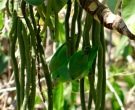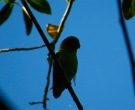Content |
|---|
Description:
13–14 cm. in length and 30–37 grams in weight.
The Mexican Parrotlet (Forpus cyanopygius) has lores, cheeks, forecrown and headphones coverts, brighter yellowish green.
The average area crown to the top of the back, green; lower back, rump and uppertail-coverts, turquoise. big blankets turquoise, other coverts, green. Primaries green, secondaries dark turquoise blue color with narrow edges outerweb. Under the wings turquoise blue and green, the flight feather dark blue-green. Underparts green tinged with yellow. Upper, the tail is green; undertail, duller. Bill and cere pale grayish; bare periophthalmic grey; irises dark brown; legs pink.
Female all green. Immature as female, with some blue feathers on the rump and in the wing-coverts, in the case of young male.
hybrids:
Forpus [conspicillatus x cyanopygius] (hybrid)
Forpus [heaven x cyanopygius] (hybrid)
Forpus [cyanopygius x passerinus] (hybrid)
- Sound of the Mexican Parrotlet.
Description 2 subspecies:
Two subspecies. But, some authorities regarded the northern birds range as a third subspecies (Forpus cyanopygius pallidus), doubtfully distinct from the nominees. See also Note on Blue-winged Parrotlet (Forpus xanthopterygius).
-
Forpus cyanopygius cyanopygius
(Souance, 1856) – Subspecies nominal.
-
Forpus cyanopygius insularis
(Ridgway, 1888) – Larger, with the gray-green. The male It has darker markings and turquoises bill darker.
Habitat:
The habitat of the Mexican Parrotlet They are gallery forests and deciduous forests, plantations, scrub, semiarid open field and trees cultivated areas; mainly observed in lowlands and foothills with the highest number of records in the south of Sonora to 360-455 m; at higher altitudes in western Durango and Zacatecas, with upper limit to 1.320 m.
Birds in breeding abilities have been observed above the 900 meters indicating possible breeding at higher altitudes. Gregaria, forming flocks 4-30 or more, sometimes in the company of Orange-fronted Parakeet (Eupsittula canicularis).
Reproduction:
breeding season may July. Clutch three eggs in captivity.
Food:
Little information about diet or creation: birds observed taking fruits the Ficus, berries and grass seed soil.
Distribution and status:
Size of its range (breeding/resident): 177.000 km2
Endemic West Mexico from Alamos in the South of Sonora to the South by Sinaloa, Nayarit (including the Islands Three Marias) and Jalisco until Colima, with the southernmost record in the Manzanillo Bay (19 ° 03’N).
Its range extends eastward Durango and Zacatecas. irregular population with widely fluctuating local abundance, perhaps in relation to the availability of local foods. There has been a large-scale modification of habitats within range but the species remain common (at least locally). The birds in the Tres Marias Island Perhaps they are in risk of extinction.
Distribution 2 subspecies:
-
Forpus cyanopygius cyanopygius
(Souance, 1856) – Subspecies nominal. shed peaceful of Mexico from Sinaloa until Colima.
-
Forpus cyanopygius insularis
(Ridgway, 1888) – Tres Marias Islands
Conservation:
State of conservation ⓘ |
||
|---|---|---|
 Near Threatened ⓘ (UICN)ⓘ
Near Threatened ⓘ (UICN)ⓘ
| ||
• Current category of the Red List of the UICN: Near-threatened.
• Population trend: In decline.
Rationale for the Red List category
The species has risen to near threatened because its population has probably been reduced to a rate close to 30% during three generations (12 years), depending on the estimated operating levels and reducing the area of ​​occupancy and extent of occurrence; almost meet the listing requirements as threatened under the criteria A2cd + 3cd + 4cd. If the declinations are found to exceed the 30% then the species would qualify to lift to Vulnerable. If there is evidence suggesting that the global population of this species is <10.000 mature individuals, and it is suffering a steady decline in> 10% in three generations (until 100 years in the future), would also qualify to lift Vulnerable.
Justification of the population
Partners in Flight estimated that the population in number of less than 50.000 individuals (A. Punjabi in some. 2008), so it is placed in the band 20.000 to 49.999 copies here.
Justification of trend
It is suspected that the population is declining rapidly due to moderately heavy pressure from his capture by illegal trade (Cantu et al ., 2007, Marín-Togo et al ., 2012). According to reports, the population of the island Three Marias It has decreased (Collar y Bushman 2014).
Threats
The capture for trade in wild birds It poses a serious threat to a 8.000 individuals illegally caught per year (Cantu et al ., 2007). The range of the species is within one of the main routes for the illegal trade of parrots in Mexico and it is thought that the heavy exploitation of the species is an important factor in their apparent absence of suitable habitat areas.
Conservation actions and research in progress
CITES Appendix II.
Conservation and research actions proposed
Implement legislation to prevent illegal trade. Raise awareness of the species.
"Mexican Parrotlet" in captivity:
Quite frequently seen in aviculture.
Capture for trade in wild birds represents a serious threat to a 8.000 individuals illegally caught per year.
In captivity is not a very long-lived bird; according to sources a specimen lived 10,5 years in captivity.
Each captive specimen of this species which is capable of reproducing, should be placed in a well-managed captive breeding program and not be sold as a pet, in order to ensure its long-term survival.
Alternative names:
– Blue-rumped Parrotlet, Mexican Parrotlet (English).
– Perruche-moineau à croupion bleu, Perruche-moineau turquoise, Toui du Mexique (French).
– Blaubürzel-Sperlingspapagei (German).
– Tuim-mexicano (Portuguese).
– Catita Enana Mejicana, Cotorrita Mexicana, Perico Catarina, Periquito Mexicano (español).
scientific classification:
Order: Psittaciformes
Family: Psittacidae
Genus: Forpus
Scientific name: Forpus cyanopygius
Citation: (Souancé, 1856)
Protonimo: Psittacula cyanopygia
Images Mexican Parrotlet:
Video of the "Mexican Parrotlet"
“Mexican Parrotlet” (Forpus cyanopygius)
-
Sources:
– Avibase
– Parrots of the World – Forshaw Joseph M
– Parrots A Guide to the Parrots of the World – Tony Juniper & Mike Parr
– Birdlife
– Photos: Richard E. Webster, XC353214. accessible www.xeno-canto.org/353214
(1) – Mexican Parrotlet (Forpus cyanopygius) in Durango Highway,Sinaloa By Ron Knight from Seaford, East Sussex, United Kingdom (Mexican Parrotlet (Forpus cyanopygius)) [CC BY 2.0], via Wikimedia Commons
(2) – MEXICAN PARROTLET by Bryant Olsen – Flickr
(3) – MEXICAN PARROTLET by Bryant Olsen – Flickr
(4) – Mexican Parrotlet – Forpus cyanopygius city Laurel PARSHALL – Flickr
(5) – Mexican Parrotlet – Forpus cyanopygius city Laurel PARSHALL – Flickr
(6) – Iconographie des perroquets :. Paris :P. Bertrand,1857.. by Biodiversity Heritage Library – Flickr
– Sounds: Richard E. Webster, XC353214. accessible www.xeno-canto.org/353214






